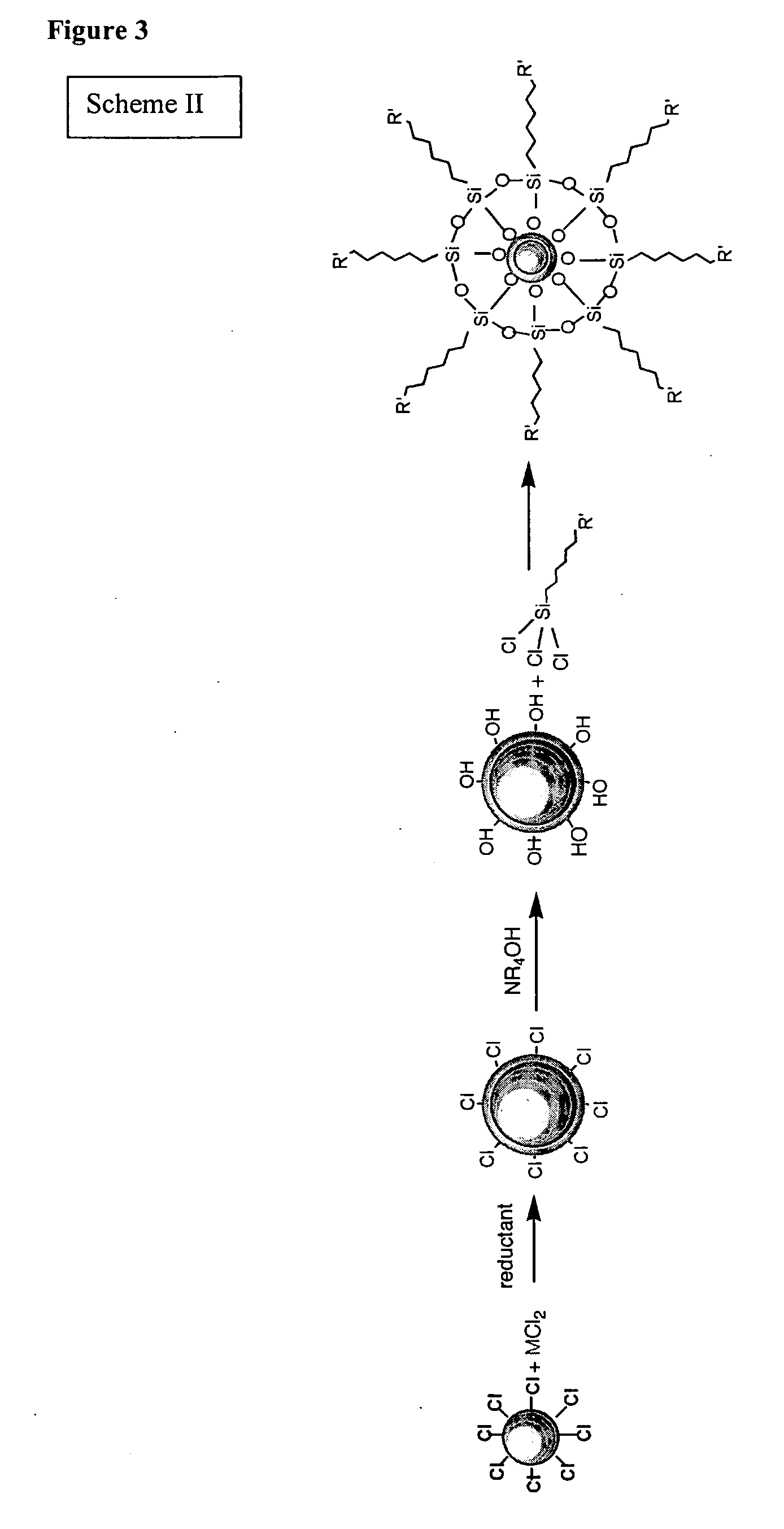Agents for use in magnetic resonance and optical imaging
a technology of magnetic resonance and optical imaging, applied in the field of imaging agents, can solve the problems of poor resolution, limited nanoparticle application, and limited application of luminescent nanoparticles in vivo
- Summary
- Abstract
- Description
- Claims
- Application Information
AI Technical Summary
Benefits of technology
Problems solved by technology
Method used
Image
Examples
example 1
Cd1-xMnxSe
[0058] Cd1-xMnxSe was synthesized from the organometallic complex Mn2(μ-SeMe)2—(CO)8 via a high-temperature pyrolysis process (Mikulec et al., 2000). This method was followed and Mn-doped CdSe nanoparticles were synthesized. The compound Mn2(μ-SeMe)2—(CO)8 was synthesized, which was confirmed by some of the characterization results such as infrared spectrum and chemical analysis. FIG. 6 shows the IR spectra of both the compound Mn2(μ-SeMe)2—(CO)8 and starting material of Mn(CO)5Br.
[0059] Cd1-xMnxSe nanoparticles were then prepared in a mixture of tri-n-octylphosphine oxide (TOPO) and hexadecylamine (HDA) by use of the synthesized compound of Mn2(μ-SeMe)2—(CO)8 as Manganese source. FIG. 7 shows the results from TEM measurement. As shown in FIG. 7A, the synthesized Cd1-xMnxSe nanoparticles were nearly monodispersed and uniform with a particle size 7.7 nm. FIG. 7B shows Manganese was contained in the particles. FIG. 7C shows a schematic of the surface covered with an organi...
example 2
Doping Manganese in the Quantum Shell
[0061] The above-mentioned method is an effective one for incorporating Manganese into CdSe nanoparticles. However, limitations exist in the low level of Mn-doping and the possibility of decreasing the photoluminescent efficiency. To overcome these problems, a new material containing a CdSe core and a manganese-doped ZnS (or CdS) shell was developed. Compared with Cd1-xMnxSe particles, the new material has the following advantages: (1) Manganese could be doped with much higher concentration due to the comparable parameters of crystal lattice between Manganese and ZnS (or CdS), (2) there is improvement of the photoluminescent efficiency due to the ZnS (or CdS) shell, and (3) Manganese does not enter the crystal lattice of CdSe, accordingly, the doping will not affect the perfection of CdSe crystal lattice. FIG. 15A shows a comparison of the emission profiles between the dye of rhodamine 6 G and CdSe / ZnS nanoparticles. FIG. 15B depicts the XRD pat...
example 3
Preparation of Zn1-xMnxS / SiO2 Using Microemulsion Method
[0068] Strategy for the synthesis In typical synthesis, Zn1-xMnxS nanoparticles form in a reverse microemulsion phase composed of nonionic surfactant olyoxyethylene nonaphenyl ether (Igepal CO-520). The synthesis involves the following procedures: a dilute (NH4)2S solution is added to one microemulsion solution while a dilute Zn(NO3)2 and Mn(NO3)2 solution is added to the other. After equilibration, the two aliquot microemulsions are mixed and allowed to stand overnight. The silica coating is generated by the addition of ammonium hydroxide and tetraethoxysilane to the Zn1-xMnxS-contained microemulsion system. After 18 hours, the resulting Zn1-xMnxS / SiO2 nanoparticles are isolated by adding acetone to the microemulsion system followed by centrifugation and washing with cyclohexane and methanol for few times. Zn1-xMnxS / SiO2 nanoparticles of core-shell structure are thus obtained. To synthesize a nanocomposite of Zn1-xMnxS homoge...
PUM
 Login to View More
Login to View More Abstract
Description
Claims
Application Information
 Login to View More
Login to View More - R&D
- Intellectual Property
- Life Sciences
- Materials
- Tech Scout
- Unparalleled Data Quality
- Higher Quality Content
- 60% Fewer Hallucinations
Browse by: Latest US Patents, China's latest patents, Technical Efficacy Thesaurus, Application Domain, Technology Topic, Popular Technical Reports.
© 2025 PatSnap. All rights reserved.Legal|Privacy policy|Modern Slavery Act Transparency Statement|Sitemap|About US| Contact US: help@patsnap.com



